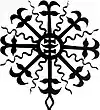Žemyna
Žemyna (from Lithuanian: žemė – earth)[lower-alpha 1] is the goddess of the earth in Lithuanian religion. She is usually regarded as mother goddess and one of the chief Lithuanian gods similar to Latvian Zemes māte. Žemyna personifies the fertile earth and nourishes all life on earth, human, plant, and animal. All that is born of earth will return to earth, thus her cult is also related to death.[2] As the cult diminished after baptism of Lithuania, Žemyna's image and functions became influenced by the cult of Virgin Mary.[3]
| Žemyna | |
|---|---|
Earth | |
 | |
| Consort | Perkūnas or Praamžius |
| Part of a series on |
| Baltic religion |
|---|
 |
|
Name
Žemyna stems from the name of Proto-Indo-European Earth-goddess *Dʰéǵʰōm.[4] It relates to Thracian Zemele ('mother earth') and Greek Semelē (Σεμέλη).[5][6][7]
Role
Žemyna was first mentioned by Jan Łasicki (1582). It was later also described by Mikalojus Daukša (1595), Daniel Klein (1653), Matthäus Prätorius, Jacob Brodowski (1740), and in numerous folk legends, beliefs, and prayers.[3] Prätorius described a ritual, called žemyneliauti, performed at major celebrations (e.g. weddings) or agricultural works (e.g. harvest). The head of the household would drink a cup of beer, but first, he would spill some of the drink on the ground and say a short prayer. Then he would kill a rooster or a hen, which would be cooked and eaten by the entire family. Each family member would receive a loaf of bread and say prayers, blessings, and greetings. The bones and other scraps would be sacrificed to the goddess (burned or buried).[3] Other recorded rites included burying bread baked from last crops of prior harvest in a field before new sowing and sacrifice of a black piglet.[8] People would also kiss the earth saying a short prayer thanking Žemyna for all her gifts and acknowledging that one day they will return to her.[9] People addressed Žemyna in various affectionate diminutive names and epithets.
The goddess is said to be married to either Perkūnas (thunder god) or Praamžius (manifestation of chief heavenly god Dievas). Thus the couple formed the typical Indo-European pair of mother-earth and father-sky.[10] It was believed that the earth needs to be fertilized by the heavens (rain and thunder). Thus it was prohibited to plow or sow before the first thunder as the earth would be barren.[9]
In modern culture
The Lithuanian folk music group Kūlgrinda in collaboration with Donis released an album in 2013 titled Giesmės Žemynai, meaning "Hymns to Žemyna".[11]
Footnotes
- Recorded alternate names for her are Žemynėlė and Žemelė.[1]
See also
References
- Laurinkiene, Nijole. "Gyvatė, Žemė, Žemyna: vaizdinių koreliacija nominavimo ir semantikos lygmenyje". In: Lituanistika šiuolaikiniame pasaulyje. Vilnius: Lietuvių literatūros ir tautosakos institutas, 2004. pp. 285–286.
- Laurinkienė, Nijolė. "Požemio ir mirusiųjų karalystės deivė" [Goddesses of the Kingdom of the Dead and the Underworld]. In: Metai n. 1. 2010. pp. 116-127.
- Balsys, Rimantas (2010). Lietuvių ir prūsų dievai, deivės, dvasios: nuo apeigos iki prietaro (in Lithuanian). Klaipėdos universitetas. pp. 103–114. ISBN 978-9955-18-462-1.
- Mallory, J. P.; Adams, Douglas Q. (1997). Encyclopedia of Indo-European Culture. Taylor & Francis. p. 174. ISBN 978-1-884964-98-5.
- Dundulienė 2018, p. 111.
- Laurinkienė, Nijolė. "Motina Žemyna baltų deivių kontekste: 1 d.: Tacito mater deum, trakų-frigų Σεμέλη, latvių Zemes māte, Māra, lietuvių bei latvių Laima, Laumė ir lietuvių Austėja" [Mother-Goddess Žemyna in the context of Baltic deities]. In: Liaudies kultūra Nr. 2 (2007). p. 12. ISSN 0236-0551 https://www.lituanistika.lt/content/7871
- Duridanov, Ivan (1985). Die Sprache der Thraker. Bulgarische Sammlung (in German). 5. Hieronymus Verlag. p. 69. ISBN 3-88893-031-6.
- Gimbutas, Marija; Miriam Robbins Dexter (2001). The living goddesses. University of California Press. pp. 208–209. ISBN 978-0-520-22915-0.
- Dundulienė, Pranė (2008). Pagonybė Lietuvoje. Moteriškosios dievybės (in Lithuanian). Vilnius: Mokslo in enciklopedijų leidybos institutas. pp. 111–115. ISBN 978-5-420-01638-1.
- Sirutis, Dainius (1999). "Žemyna". In Jonas Trinkūnas (ed.). Of Gods & Holidays. The Baltic Heritage. Vilnius: Tvermė. pp. 80–83. ISBN 9986-476-27-5.
- Kūlgrinda Ir Donis – Giesmės Žemynai. Discogs.